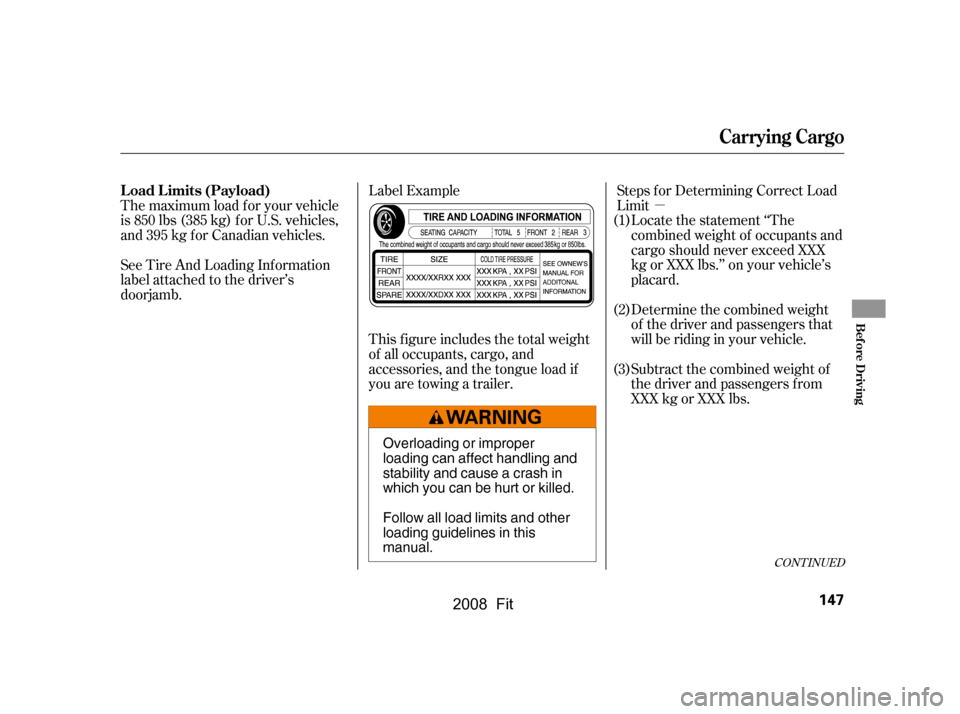Page 67 of 280

This indicator reminds you that the
exterior lights are on. It comes on
when the light switch is in either theor position. If you turn the
ignition switch to the ACCESSORY
(I) or LOCK (0) position without
turning of f the light switch, this
indicator will stay on. A reminder
chime will also sound when you open
the driver’s door.
This indicator comes on when you
turn on the fog lights. For more
inf ormation, see page .
This indicator normally comes on f or
a f ew seconds when you turn the
ignition switch to the ON (II)
position.
If it comes on while driving, it
indicates that one or more of your
vehicle’s tires are signif icantly low
on pressure.
If this happens, pull to the side of the
road when it is saf e, check which tire
has lost the pressure, and determine
the cause. If it is because of a flat tire,
replace the flat tire with the compact
spare (see page ), and have the
f lat tire repaired as soon as possible.
If two or more tires are underinf lated,
call a prof essional towing service
(see page ). For more
inf ormation, see page .
If this indicator comes on and stays
on at any other time, or if it does not
come on when you turn the ignition
switch to the ON (II) position, there
is a problem with the TPMS. With
this indicator on, the low tire
pressure indicator will not come on
when a tire loses pressure. Take the
vehicle to your dealer to have the
system checked.
This indicator normally comes on f or
a f ew seconds when you turn the
ignition switch to the ON (II)
position.
170 73
218
238U.S. models only U.S. models only
On Sport model
Low Tire Pressure
IndicatorTire Pressure Monitoring
System (T PMS) IndicatorLights On Indicator
Fog L ight Indicator
Instrument Panel Indicators
64
�\f���—�\f���—�����y���\f�����������y���
�(�������
�\f�y�\f�\f�����y
2008 Fit
Page 150 of 280

�µ
Locate the statement ‘‘The
combined weight of occupants and
cargo should never exceed XXX
kg or XXX lbs.’’ on your vehicle’s
placard.
Determine the combined weight
of the driver and passengers that
will be riding in your vehicle.
Subtract the combined weight of
the driver and passengers f rom
XXX kg or XXX lbs.
The maximum load f or your vehicle
is 850 lbs (385 kg) f or U.S. vehicles,
and 395 kg for Canadian vehicles.
See Tire And Loading Inf ormation
label attached to the driver’s
doorjamb.
Label Example
This f igure includes the total weight
of all occupants, cargo, and
accessories, and the tongue load if
you are towing a trailer.Steps f or Determining Correct Load
Limit
(1)
(2)
(3)
CONT INUED
Carrying Cargo
L oad L imits (Payload)
Bef ore Driving
147
Overloading or improper
loading can affect handling and
stability and cause a crash in
which you can be hurt or killed.
Follow all load limits and other
loading guidelines in this
manual.
�\f���—�\f���—�����y���\f�����������y���
�(�������
�\f�y�\f�
�����y
2008 Fit
Page 151 of 280

�µ�·
The resulting f igure equals the
available amount of cargo and
luggage load capacity. For
example, if the ‘‘XXX’’ amount
equals 1,400 lbs. and there will be
f ive 150 lb. passengers in your
vehicle, the amount of available
cargo and luggage load capacity is
650 lbs.
(1,400 750 (5 150) = 650 lbs.)
Determine the combined weight
of luggage and cargo being loaded
on the vehicle. That weight may
not saf ely exceed the available
cargo and luggage load capacity
calculated in Step 4.
If your vehicle will be towing a
trailer, load f rom your trailer will
be transf erred to your vehicle.
Consult this manual to determine
how this reduces the available
cargo and luggage load capacity of
your vehicle.
In addition, the total weight of the
vehicle, all occupants, accessories,
cargo, and trailer tongue load must
not exceed the Gross Vehicle
Weight Rating (GVWR) or the Gross
Axle Weight Rating (GAWR). Both
areonalabelonthedriver’s
doorjamb.Example 1
Example 2
Example 3
(4)
(5)
(6)
Carrying Cargo
148
Passenger Weight
(150lbsx2=300lbs)
Passenger Weight
(150lbsx4=600lbs)
Passenger Weight
(150lbsx5=750lbs)
Max Load (850 lbs)
Max Load (850 lbs)
Max Load (850 lbs)
Cargo Weight
(550 lbs)
Cargo Weight
(250 lbs)
Cargo Weight
(100 lbs)
�\f���—�\f���—�����y���\f�����������y���
�(�������
�\f�y�\f�
�����y
2008 Fit
Page 154 of 280
�Î�Î
�Î
This section gives you tips on
starting the engine under various
conditions, and how to operate the
manual and automatic transmissions.
It also includes important
information on parking your vehicle,
the braking system, and the tire
pressure monitoring system
(TPMS) .........................
Driving Guidelines .152
........................
Preparing to Drive .153
.......................
Starting the Engine .154
...................
Manual Transmission .155
..............
Automatic Transmission .157
Driving with the Paddle
.................
Shif ters (Sport only) .162
...........................................
Parking .166
.............................
Braking System .167
...............
Anti-lock Brakes (ABS) .168
Tire Pressure Monitoring
......................
System (TPMS) .170
...........................
Towing a Trailer .173
: If equipped
Driving
Driving
151
�\f���—�\f���—�����y���\f�������\f���y���
�(�������
�\f�y�\f�
�����y
2008 Fit
Page 176 of 280

Your vehicle is not designed to tow a
trailer. Attempting to do so can void
your warranties. Your vehicle can be towed behind amotorhome at legal highway speeds
up to 65 mph (100 km/h). Do not
exceed 65 mph (100 km/h).
Otherwise, severe transmission
damage will occur.
When purchasing a tow bar, make
sure you select a reputable
manuf acturer and installer. Follow
the manufacturer’s attachment
instructions caref ully. Press on the brake pedal. Move
the shif t lever through all its
positions.
Start the engine.
Check the transmission f luid level
(see page ).
Perf orm the f ollowing procedure
every day immediately bef ore you
begin towing. Otherwise severe
automatic transmission damage will
occur.
1.
2.
3.
193
CONT INUED
Do not overf ill.
Automatic transmission:
T owing a T railer, T owing Your Vehicle Behind a Motorhome
Towing Your Vehicle Behind a
Motorhome
Driving
173
The steering system can be damaged if
the steering wheel is locked. Leave the
ignition switch in the ACCESSORY (I)
position, and make sure the steering
wheel turns f reely bef ore you begin
towing.
�\f���—�\f���—�����y���\f�����������y���
�(�������
�\f�y�\f�
�����y
2008 Fit
Page 177 of 280

Shif t to D position and hold f or 5
seconds, then to N. Let the engine
runfor3minutes,thenturnitoff.Release the parking brake.
Leave the ignition switch in the
ACCESSORY (I) position so the
steering wheel does not lock.
Make sure the radio is of f , and
remove any item plugged into the
accessory power socket so you do
not run down the battery.If you tow more than 8 hours in one
day, you should repeat the above
procedure at least every 8 hours
(when you stop f or f uel, etc.)
4. 5.
6.
7.
Towing Your Vehicle Behind a Motorhome
Ext ended T owing
174
Severe transmission damage will occur
if the vehicle is shif ted f rom reverse to
neutral and then towed with the drive
wheels on the ground. Failure to f ollow the recommended
instructions exactly will result in severe
automatic transmission damage. If you
cannot shif t the transmission or start
the engine, your vehicle must be
transported on a f lat-bed truck or
trailer.
�\f���—�\f���—�����y���\f�����������y���
�(�������
�\f�y�\f�
�����y
2008 Fit
Page 178 of 280
If you tow your vehicle with an
automatic transmission, the Honda
Genuine ATF-Z1 transmission f luid
must be changed every 2 years or
30,000 miles (48,000 km), whichever
comes f irst.Move the shifter into the Neutral
position.
Release the parking brake.
Leave the ignition switch in the
ACCESSORY (I) position so the
steering wheel does not lock.
Make sure the radio is of f , and
remove any item plugged into the
accessory power socket so you do
not run down the battery.
1.
2.
3.
4.Manual transmission:
Towing Your Vehicle Behind a Motorhome
Driving
175
�\f���—�\f���—�����y���\f�������\f�\f�y���
�(�������
�\f�y�\f�
���\f�y
2008 Fit
Page 220 of 280

This section covers the more
common problems that motorists
experience with their vehicles. It
gives you inf ormation about how to
safely evaluate the problem and what
to do to correct it. If the problem has
stranded you on the side of the road,
you may be able to get going again.
If not, you will also f ind instructions
on getting your vehicle towed.......................
Compact Spare Tire .218
....................
Changing a Flat Tire .219
.............
If the Engine Won’t Start .224
................................
Jump Starting .226
..............
If the Engine Overheats .228
.........
Low Oil Pressure Indicator .230
..........
Charging System Indicator .230
.......
Malf unction Indicator Lamp .231
...............
Brake System Indicator .232
..............................................
Fuses .233
..............................
Fuse Locations .236
......................
Emergency Towing .238
..........
If Your Vehicle Gets Stuck .239
Taking Care of the Unexpected
T aking Care of t he Unexpect ed
217
�\f���—�\f���—�����y���\f�����������y���
�(�������
�\f�y�\f�������y
2008 Fit